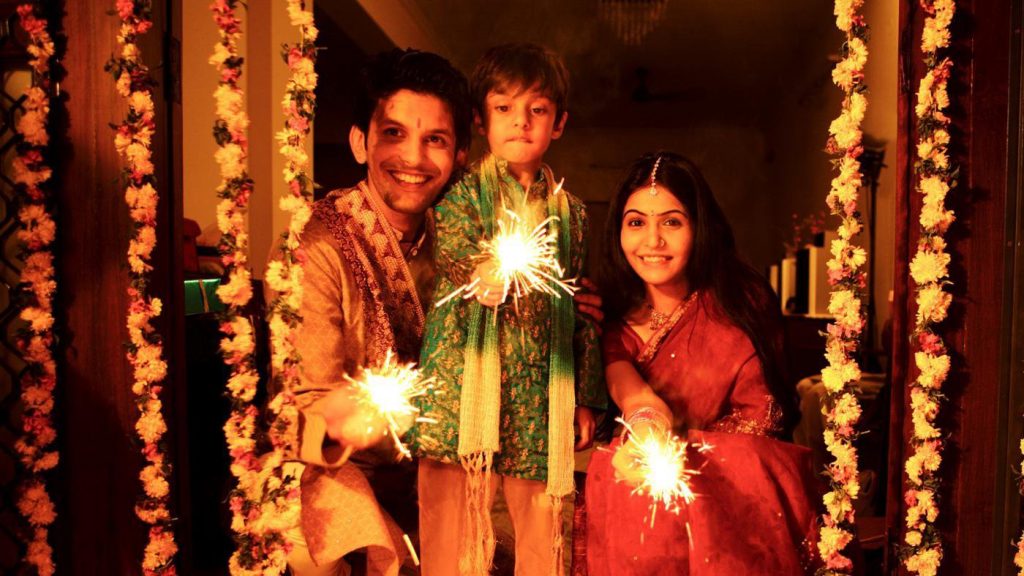How Diwali celebrates ‘Grihasthashrama’, the family!

The family is an important institution that plays a crucial role in the lives of most Indians. In this era of nuclear families, where we experience clashes and misunderstanding on multiple occasions, the survival and dignified growth of family relationships becomes a concern. Diwali is not only a festival of lights but also the festival of family relations and celebration. In Ancient India, for the optimum fulfillment, satisfaction and peace in one’s life, it was advisable to live one’s life since childhood to the end of life in simplified four stages with assigned duties also called as the ‘ashramas’ or ‘Varnashramadharma’.
Varnashramadharma
The Varnashramadharma system is of four age-based life stages discussed in Indian texts of the ancient and medieval eras. Under this system, the human lifespan was divided into four major periods. The child begins his or her life with Brahmacharya stage as a student, then progresses to the Grihastha stage of a householder, then retires to Vanaprastha stage and finally accepts the Sanyasa stage of renunciation. According to Indian philosophy, it is equally important to live one’s life to the fullest while discharging his or her duties, as is the penance and spiritual growth to attempt to achieve salvation. The Brahmacharya Ashrama stage represented the bachelor or student stage of life. This focuses on the education of the child.
The Grihasthashrama stage is represented after the marriage of an individual, when he begins his family life and was considered the most important of all stages in the social, cultural and economic context, as human beings not only pursued a virtuous life, they produced food and wealth that sustained people in other stages of life as well as the offsprings that continued mankind. This stage also represented where the most intense physical, sexual, emotional, occupational, social and material attachments exist in a human beings life. Then the Vanaprasthashrama stage or the retirement and relaxation stage of a person and finally the Sanyasashrama stage or the renounced life. This stage marked the renunciation of material desires and focused on peace, moksh or salvation and simple spiritual life. Anyone could enter this stage after completing the Brahmacharya stage in life. The family system creates a strong bond of unity at an early age, paves the way for social cohesion and in a broader sense promotes national unity.
Diwali Celebrates the Grihastha
Mostly, all the festivals in India, are centered around this concept of celebration with family and friends, highlighting a specific concern, however Diwali celebrates the Grihastha stage to the fullest sense by focusing on the multiple aspects and qualities of it, highlighting the need to enjoy and appreciate each member of the family with deserving importance and their mutual bonding with other members of the family. It is almost a complete package of a five day celebration of coordination of members of family, respect towards each other, love, affection, care and sharing, human values of forgiving, gratitude and humility.
Diwali
Often considered one of the biggest festivals in India, Diwali that begins on the onset of autumn, at the end of the cropping season, is celebrated with lots of fanfare and is believed to have a mention in Ancient Indian scriptures like the Skanda Purana and Padma Purana.This festival of lights, indicates the triumph of light over darkness and good over evil. The grand five day celebrations begin with Dhanteras, the festival of wealth and is followed by Naraka Chaturdashi on the second day. On the third day, we celebrate Diwali- Lakshmi Pujan, on the fourth day, Diwali Padwa and finally Bhau beej marks the fifth glorious day and the end of the festival.
Dhanteras
The Dhanteras, also called as Dhanatrayodashi, is the worship of Lord Dhanvantari – the God of health and ayurveda. On the night of Dhanteras, diyas or lamps are ritually kept burning all through the night in honour of goddess Lakshmi and Dhanvantari. Hindus consider it an extremely auspicious day to make new purchases for one’s family or business, to buy new ‘dhan’, some form precious metals especially Gold or Silver articles and new utensils. Dhanteras engages cleansing, renewal and the securing of auspiciousness in the form of Lakshmi. The day is aimed at increasing wealth and prosperity in the family and so the nation. In villages, cattle are adorned and worshipped by farmers as they form the main source of their income.
Naraka chaturdashi
The Naraka chaturdashi also known as Kali Chaudas or choti Diwali is a very beautiful day for the family bonding, fun moments and celebration. The Ancient literature narrates that the asura (demon) Narakasura was killed on this day by Krishna, Satyabhama and Kali. It is also the day to abolish laziness, and evil which creates hell in our life. On this day, families wake up before sunrise and begin the day with ‘abhyanga snan’ – sacred bath before dawn with ‘ubtan’- holy scrub. It is specifically prepared scrub using chandan, amba haldi, multani mitti, rose petal powder etc. They rub it off over their entire body, before bath and it’s believed that all your worries are warded off and happiness fulfills your life. It signifies washing off all kinds of impurities to attract health, wisdom and prosperity, cleansing your mind of negativity too. A small puja is performed with oil lamp, flowers, sandalwood etc. Women in the house perform aarti of men. Before bath elders in the family apply perfumed oil on the heads of the younger members and also apply ubtan on their body. It is also a gesture to end any kind of misunderstandings, mutual fights or negatively and strengthen relationships. After the bath, clean or new clothes are worn.
Celebration
Early morning, the house is decorated with diyas and rangolis. Colourful rangolis are either drawn with rangoli powder or made with flowers to welcome goddess Lakshmi into the house. It is said that the goddess is more likely to visit a home that is clean and decorated in her honour. Feet patterns are drawn to symbolise lakshmi’s presence in the house. Other patterns include those inspired from sun, moon, flowers, creepers, religious symbols like swastika and Om. It is also believed to bring colour and joy in the hearts of the families. An elaborate breakfast of traditional and delicacies specific to Diwali, also known as ‘faraal’ is enjoyed with family and relatives. The snacks mostly include chakli, sev, chivda, ladoo,
barfis, shakarpara, sweets and other regional delicacies. The delicacies are also elaborate and prepared mostly by the family which is also quality time shared by family members. In the evening, people enjoy with relatives and friends. They go to each other’s houses, exchange gifts and enjoy feasting on lots of delicacies and sweets. Diwali is an auspicious occasion to exchange gifts and sweets which symbolises the expression of love, warmth, togetherness, respect, thankfulness, gratitude, and appreciation for one’s near and dear ones. People also burst crackers during diwali. It is believed that bursting crackers keeps evil spirits away from the home. Although today, due to increasing air pollution and crowded cities, crackers can be enjoyed in limits. The houses, doorways and the nearby areas are lit with colourful lights and lamps during this time. The family members should also take the lead to light the inner lamp in their hearts and souls for a happy, peaceful togetherness in their lives.
Legend has it that people of ayodhya decorated the entire town with diyas to celebrate Lord Ram’s return from fourteen years exile. Hence, people light their houses and doorways with diyas to dispel the darkness of amavasya, a ritual that symbolises warding off the darkness of evil with the light of goodness. People also believe that since Diwali falls on the no-moon night, diyas help goddess Lakshmi find her way into their households through darkness.
Lakshmi Pujan
The third day of Diwali is celebrated as the Lakshmi Pujan, According to legend, Lakshmi, the goddess of wealth and lord Vishnu’s wife, visits her devotees and bestows gifts and blessings upon each of them. Lakshmi is believed to roam the earth on the night of Lakshmi Pujan. On the evening of Lakshmi Pujan, people open their doors and windows to welcome Lakshmi, and place diya lights on their windowsills and balcony ledges to invite her in. She symbolises wealth and prosperity, and her blessings are invoked for a good year ahead.
Lakshmi Puja consists of a combined puja of five deities: Ganesha is worshiped at the beginning of every auspicious act as Vighneshvara; goddess Lakshmi is worshiped in her three forms; Mahalakshmi, the goddess of wealth and money, Mahasaraswati the goddess of books and learning, and Mahakali. Kubera, the treasurer of the gods is also worshiped by drawing a Swastika symbol on the safe or vault in which the devotee keeps their valuables. On this day, the mothers, who work hard all year, are recognized by the family. Mothers are seen to embody a part of Lakshmi, the good fortune and prosperity of the household. After the puja, people go outside and celebrate by lighting up fireworks or enjoying a get-together and ambience around.
Padwa and Bhai Dooj
The fourth day of Diwali is called as Diwali Padwa or Bali Pratipada, which celebrates the bond between the wife and husband. On the day of Padwa, the wife normally gets dressed in her traditional wear with jewellery and prays for the long life, wealth and prosperity of her husband and husband reciprocates his love and care towards his wife with gifts and blessings. Married daughters and son-in-laws are also honoured with gifts and sweets on Padwa. According to the scriptures, Bali Pratipada commemorates the victory of god Vishnu in his dwarf incarnation Vamana, the fifth incarnation of the Dashavatara (ten major incarnations of Vishnu) defeating Asura (demon) Bali, and pushing him to the nether world. However, pleased with the generosity of Bali, and his devotion to the Lord and for his noble deeds to his people, Vishnu granted him a boon that he could return to earth for one day in a year to be with his people and light millions of lamps to dispel the darkness and ignorance and spread the radiance of love and wisdom. It is this day that is celebrated as the Bali Pratipada, the annual return of Bali from the netherworld to earth.
The five-days of Diwali conclude with Bhau beej, a day dedicated to the bond of brothers and sisters! Bhau beej is also called as Bhai dooj, Bhai Tika and Bhai Phonta. On the day of the festival, sisters invite their brothers for a sumptuous meal often including their favorite dishes and sweets. The whole ceremony signifies the duty of a brother to protect his sister, as well as a sister’s blessings for her brother. It is also a day to forget any mutual fights, tension or negatively and continue relations with positivity and affection. Carrying forward the ceremony in a traditional style, sisters perform aarti for their brother and apply a red tika on the brother’s forehead. This tika ceremony on the occasion of Bhau Beej signifies the sister’s sincerest prayers for a long and happy life of her brother and they also welcome them with sweets and brothers bless their sisters with gifts and sweets. As it is mostly customary to celebrate the auspicious occasion of Bhau-beej, women who do not have a brother, worship the moon god instead. They apply mehendi on girls as their tradition. The sister whose brother lives far away from her and cannot go to her house, sends her sincerest prayers for a long and happy life of her brother, through the moon god. She performs aarti for the moon. This is the reason why children of Hindu parents affectionately call the moon Chandamama (Chanda means moon and mama means
mother’s brother).
Conclusion
Thus Diwali underlines the concept of how the Grihasthashrama stage in a person’s life may be enjoyed for happiness and joy, while discharging his or her own responsibilities and duties. The fun element in the family coordination is brought out well in Diwali, while learning to be together and care for one another, including the relatives and one’s own neighbours. We all know about these concepts and human values but Diwali reminds us of our greatest wealth and resource in life that lies in our family, our integral support system. The affection between siblings, husband, wife, children, grand parents, their care, hygiene and joy, that needs to grow and to be maintained not only for these five days but for throughout the year and life, praying to the almighty for wealth and happiness, while also paying gratitude for
what one has achieved as blessings.





